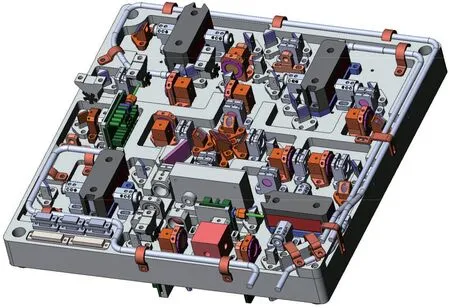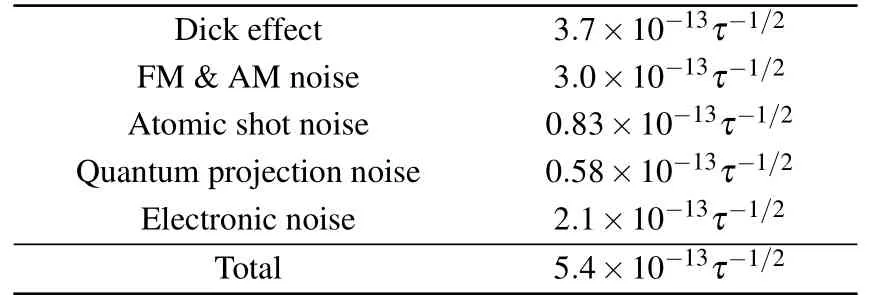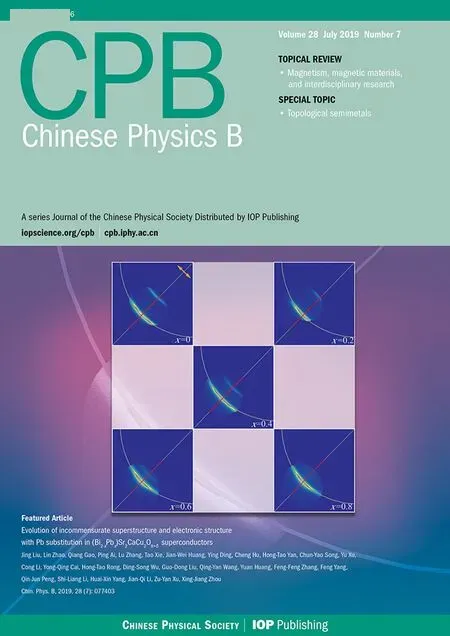Development of the integrated integrating sphere cold atom clock∗
2019-08-06MingYuanYu于明圆YanLingMeng孟艳玲MeiFengYe叶美凤XinWang王鑫XinChuanOuyang欧阳鑫川JinYinWan万金银
Ming-Yuan Yu(于明圆), Yan-Ling Meng(孟艳玲), Mei-Feng Ye(叶美凤),Xin Wang(王鑫), Xin-Chuan Ouyang(欧阳鑫川), Jin-Yin Wan(万金银),
Ling Xiao(肖玲)1, Hua-Dong Cheng(成华东)1,†, and Liang Liu(刘亮)1,‡
1Key Laboratory of Quantum Optics,Shanghai Institute of Optics and Fine Mechanics,Chinese Academy of Sciences,Shanghai 201800,China
2Center of Materials Science and Optoelectronics Engineering,University of Chinese Academy of Sciences,Beijing 100049,China
Keywords: integrating sphere cold atom clock,physical package,laser system,frequency stability
1. Introduction
Atomic clocks are used in many different fields, such as navigation, time keeping, and fundamental physics research.[1,2]Consequently,many kinds of atomic clocks have been developed, such as chip-scale atomic clock,[3]hydrogen maser,[4]pulsed optical pump atomic clock (POP) based on vapor cell,[5,6]microwave Hg ion clock,[7,8]integrating sphere cold atom clock,[9,10]atomic fountain,[11-13]and optical clock.[14-16]Although atomic fountains are the contemporary primary frequency standard and an ultra-high precision of 10-19is achieved for the optical clock,[14]the compact microwave atomic clocks play an important role in global positioning systems due to their small size and good frequency stability.
Atomic beam slowing by diffuse light was an early proposal made by Wang,[17]and the diffuse laser cooling and slowing of Na atomic beams were first demonstrated by Ketterle et al.[18]The diffuse light cooling atoms directly from an atomic vapor background was then realized by Guillot et al.[19]and Cheng et al.[20]The compact cesium clock (HORACE) has been developed and the short-term stability of 2.2×10-13τ-1/2(τ is the integration time in seconds) and 3×10-15at the integration time of 104s were achieved.[9,21]We developed a similar compact atomic clock, an integrated integrating sphere cold atom clock (ISCAC), with rubidium atoms. The ISCAC is designed for onboard and space applications. It has good performance, especially in microgravity,because the lifetime of cold atoms in space is nearly one order longer than that on earth. Recently, the long term frequency stability of 2×10-15has been reached for the principle prototype of the ISCAC.[10,20,22]
This paper mainly introduces the latest progress of the integrated ISCAC. The principle of the ISCAC is described in Section 2. The experimental set-up, mainly including the physical and optical systems,is introduced in Section 3. Section 4 describes the experimental result. Then,the experimental result is analyzed in Section 5. Finally, the conclusion is drawn in Section 6.
2. Principle
The ISCAC is a cold atom clock based on the diffuse light cooling and operated at a POP scheme.The cooling light is injected into the microwave cavity and reflected by the inner surface of the cavity,whose diffuse reflectivity is about 97%,and the diffuse light cooling of the87Rb vapor is performed inside the microwave cavity,which locates in the ultra-high vacuum cavity. After the laser cooling phase,the cold atoms populate in the states|F =2,mF=0,±1,±2〉,and are then pumped to the states |F =1,mF=0,±1〉 by an optical pumping pulse.The Ramsey microwave interrogation is performed to make the clock transition of |F =1,mF=0〉→|F =2,mF=0〉.Finally, the population of the cold atoms in the state |F =2,mF=0〉is detected by an optical pulse. The time sequence of the ISCAC is shown in Fig.1.
The Allan deviation can be used to evaluate the frequency stability of an atomic clock and expressed as[23]

where C and RSNare the contrast[21]and signal-to-noise ratio of the Ramsey fringe,respectively; Δν is the linewidth of the Ramsey fringe, ν0is the frequency of the clock transition, τ is the averaging time; and Tcis the cycle period of the clock.The relationship Δν ~1/2Tfis satisfied,which means that the longer Tfcorresponds to the narrower Δν, but the RSNand C will decrease as Tfincreases. However,there is a tradeoff between them. For the ISCAC,the lifetime of cold atoms,which is about 40 ms in the ground environment, is mainly determined by the free fall time of the cold atoms in the microwave cavity.[24]However,the lifetime of cold atoms can reach more than 200 ms in space,which corresponds to narrower linewidth of the Ramsey fringe. At the same time, the Dick effect[25]would be neglected. So the ISCAC would have better performance in a microgravity environment than on earth.

Fig.1. Time sequence of the ISCAC.
3. Experimental setup
The ISCAC is mainly composed of four subsystems:physical package, laser system, microwave source, and electronics. Figure 2 shows the physical package. A cylindrical microwave cavity is designed for the diffuse light cooling and microwave interrogation. For the diffuse light cooling,the inner surface of the microwave cavity is coated to increase the diffuse reflectance at 780 nm,and the cooling light is injected into the microwave cavity by four 3-mm holes distributed centro-symmetrically in the undersurface of the cavity,which can make most of cold atoms distribute in the detection region.[26]For microwave interrogation, the 6.834 GHz signal is coupled into the cavity by a coupling loop installed in the middle of the cylinder,and the microwave cavity is operated in the TE011mode with a quality factor about 22000.The microwave cavity is installed in the vacuum chamber with a volume about 1.5 L, in which the vacuum is maintained at 10-6-10-7Pa by two ion pumps. The biased magnetic field is about 0.6µT and the stray magnetic field is less than 2 nT after shielding with three layers ofµ-metal. The temperature stabilization is used to keep the microwave cavity working at the temperature of 34°C.

Fig.2. The physical package of the ISCAC.

Fig.3. The laser system of the ISCAC.
For future space-borne applications, the laser system must be developed with higher miniaturization and compactness. Figure 3 shows the compact laser system of the ISCAC. All the optical components are integrated on two sides of an aluminum baseplate with the dimensions of 300 mm×300 mm×20 mm.Three external cavity diode lasers are used to produce the cooling, repumping, pumping, and probe lights. Four acousto-optic modulators(AOM)are used to frequency-shift the light properly. The mechanical design and simulation of the optical bench are performed to optimize the stability of the light paths. The lights are injected into the physical package in free space,which is different from the multimode fiber connection for the principle prototype of the ISCAC.This free space mode not only has higher laser injection efficiency but also has higher tolerance for the deformation of the optical bench. Figure 4 shows the integrated physical package and laser system. Furthermore, a miniaturized frequency synthesizer(FS)is also developed.[27]Its output frequency resolution is 0.71 µHz, and its output power range is from-87.41 dBm to-26 dBm with a resolution of 0.02 dB.

Fig.4. (a)The integrated physical package and laser system(b)and its photo.
4. Experimental results
The time sequence of the clock is optimized first. The light switches based on the step motors are used and the extinction ratio better than 100 dB is achieved. The rotation of the step motor is controlled by a trigger voltage pulse.The delay time of the step motor is measured carefully. According to the measured results, we have optimized the time sequence and make sure that the light and microwave pulses are non-overlapping. Figure 5 shows the time sequence of the ISCAC. The cooling phase lasts for 55 ms, followed by an optical pump of 1.6 ms, then two microwave pulses with a duration of 1 ms separated by 24 ms are applied for the Ramsey microwave interrogation, and finally the population of cold atoms experiencing the clock transition is optically detected for 7 ms. The entire atomic clock operates with a period of 90 ms. In addition,the laser power stabilization and temperature control of the whole system are also optimized carefully. The optimized Ramsey fringe is shown in Fig.6(a),and the linewidth and signal-to-noise ratio(SNR)of the fringe are about 20 Hz and 518, respectively. The frequency stability of the ISCAC is measured with the three-cornered hat method[28]by comparing with two H-masers for about 11 days, the result is shown in Fig. 6(b). The short-term frequency stability is about 5.4×10-13τ-1/2(τ is the averaging time), and the frequency stability of 2.9×10-15at 1-day integrating time is achieved.

Fig.5. The optimized time sequence of the clock operation.

Fig.6. (a)The Ramsey fringe. (b)The stability of the integrated ISCAC.
5. Discussion
The main limits of the short-term frequency stability of the ISCAC stem from the Dick effect, atomic shot noise, frequency and intensity fluctuations of the probe light (FM and AM noise),[9]and electronic noise. The noise budget of the system and the instabilities of the noise sources are shown in Table 1.

Table 1. Noise budget of the system and the instabilities of the noise sources.
According to the time sequence shown in Fig.5,the number of detected atoms is about 1.2×107, so the short-term frequency instabilities caused by the atomic shot noise[9]and quantum projection noise[29]are about 0.83×10-13τ-1/2and 0.58×10-13τ-1/2, respectively. The Dick effect is the main contribution to the frequency stability degradation. The performance of a homemade microwave frequency synthesizer is optimized and its estimated frequency stability degradation via the Dick effect[27,30]will be reduced to 1.8×10-13τ-1/2.With future space application,when the free evolution time of the Ramsey interrogation increases to 100 ms, the frequency stability degradation caused by the Dick effect will be reduce to 0.72×10-13τ-1/2. Since the absorption detection method is used here,the clock signal is very sensitive to the intensity fluctuation of the probe light.[9]The active power stabilization has been used to suppress the intensity fluctuation(AM)of the probe light, and the measured relative intensity noise (RIN)of the probe light is -110 dBc/Hz at the offset frequency of 1 Hz. The frequency stability degradation caused by the AM noise of the probe light is about 0.63×10-13τ-1/2and that caused by the FM noise is about 2.9×10-13τ-1/2. The FM noise can be suppressed further by optimizing the frequency lock loop parameters(modulation frequency and loop gain).
6. Conclusion
In summary, we develop an integrated ISCAC and measure its frequency stability with a three-cornered hat method.After a preliminary optimization,the short-term frequency stability of 5.4×10-13τ-1/2and 2.9×10-15at 1-day integrating time are achieved and further optimization is in progress.At the same time, we are currently developing an ISCAC for space application and in the near future we will obtain the new results.
猜你喜欢
杂志排行
Chinese Physics B的其它文章
- Topological magnon insulator with Dzyaloshinskii-Moriya interaction under the irradiation of light∗
- Wavelength dependence of intrinsic detection efficiency of NbN superconducting nanowire single-photon detector∗
- Artificial solid electrolyte interphase based on polyacrylonitrile for homogenous and dendrite-free deposition of lithium metal∗
- Effects of CeO2 and nano-ZrO2 agents on the crystallization behavior and mechanism of CaO-Al2O3-MgO-SiO2-based glass ceramics∗
- Modulation of magnetic and electrical properties of bilayer graphene quantum dots using rotational stacking faults∗
- Thermal conductivity characterization of ultra-thin silicon film using the ultra-fast transient hot strip method∗
